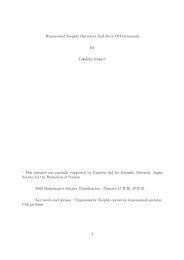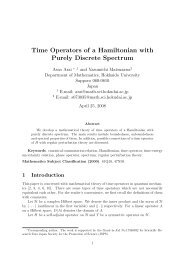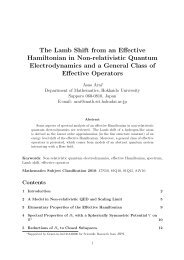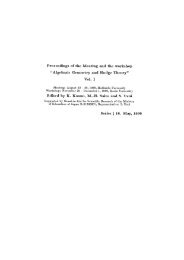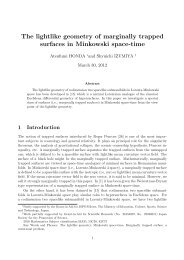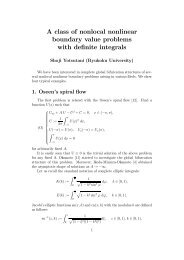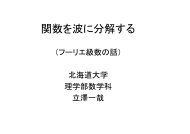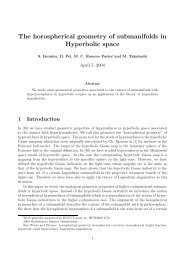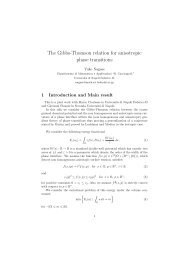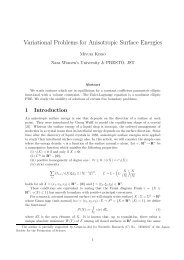Contact Geometry of second order I - Dept. Math, Hokkaido Univ ...
Contact Geometry of second order I - Dept. Math, Hokkaido Univ ...
Contact Geometry of second order I - Dept. Math, Hokkaido Univ ...
Create successful ePaper yourself
Turn your PDF publications into a flip-book with our unique Google optimized e-Paper software.
(2) There exists a c<strong>of</strong>rame { ϖ, ω1, . . . , ωn, π1, . . . , πn} defined around u ∈ J such that<br />
the following holds;<br />
dϖ ≡ ω1 ∧ π1 + · · · + ωn ∧ πn (mod ϖ)<br />
(3) The Cauchy characteristic system Ch (C) <strong>of</strong> C is trivial (see §2.3 below).<br />
By the Darboux Theorem, a contact manifold (J, C) <strong>of</strong> dimension 2n + 1 can be<br />
regarded locally as a space <strong>of</strong> 1-jets for one unknown function. Namely, at each point <strong>of</strong><br />
(J, C), there exists a canonical coordinate system (x1, . . . , xn, z, p1, . . . , pn) such that<br />
n∑<br />
C = {dz − pi dxi = 0}.<br />
i=1<br />
Starting from a contact manifold (J, C), we can construct the geometric <strong>second</strong> <strong>order</strong><br />
jet space (L(J), E) as follows: We consider the Lagrange-Grassmann bundle L(J)<br />
over J consisting <strong>of</strong> all n-dimensional integral elements <strong>of</strong> (J, C);<br />
L(J) = ∪<br />
u∈J<br />
Lu<br />
π<br />
−→ J,<br />
where Lu is the Grassmann manifolds <strong>of</strong> all lagrangian (or legendrian) subspaces <strong>of</strong> the<br />
symplectic vector space (C(u), dϖ). Here ϖ is a local contact form on J. Then the<br />
canonical system E on L(J) is defined by<br />
E(v) = π −1<br />
∗ (v) ⊂ Tv(L(J)) π∗<br />
−→ Tu(J), for v ∈ L(J).<br />
Let us fix a point vo ∈ L(J). Starting from a canonical coordinate system (x1, · · · , xn, z, p1,<br />
· · · , pn) <strong>of</strong> (J, C) around uo = π(vo) such that dx1 ∧ · · · ∧ dxn |vo= 0, we can introduce a<br />
coordinate system (xi, z, pi, pij) (1 ≦ i ≦ j ≦ n) by defining coordinate functions pij as<br />
follows;<br />
n∑<br />
dpi |v= pij(v)dxj |v .<br />
i=1<br />
Then, since v ∈ C(u), we have dz |v= ∑ n<br />
i=1 pi(u)dx |v and , since dϖ |v= 0, we get<br />
pij = pji.<br />
Thus E is defined on this canonical coordinate system by<br />
where<br />
ϖ = dz −<br />
E = {ϖ = ϖ1 = · · · = ϖn = 0},<br />
n∑<br />
pi dxi, and ϖi = dpi −<br />
i=1<br />
n∑<br />
pij dxj for i = 1, · · · , n.<br />
Let (J, C), ( ˆ J, Ĉ) be contact manifolds <strong>of</strong> dimension 2n + 1 and ϕ : (J, C) → ( ˆ J, Ĉ) be a<br />
contact diffeomorphism between them. Then ϕ induces an isomorphism ϕ∗ : (L(J), E) →<br />
(L( ˆ J), Ê). Conversely we have (cf. Theorem 3.2 [Y1])<br />
Theorem 2.1. (Bäcklund) Let (J, C) and ( ˆ J, Ĉ) be contact manifolds <strong>of</strong> dimension<br />
2n + 1. Then, for an isomorphism Φ : (L(J), E) → (L( ˆ J), Ê),there exists a contact<br />
diffeomorphism ϕ : (J, C) → ( ˆ J, Ĉ) such that Φ = ϕ∗.<br />
3<br />
j=1



